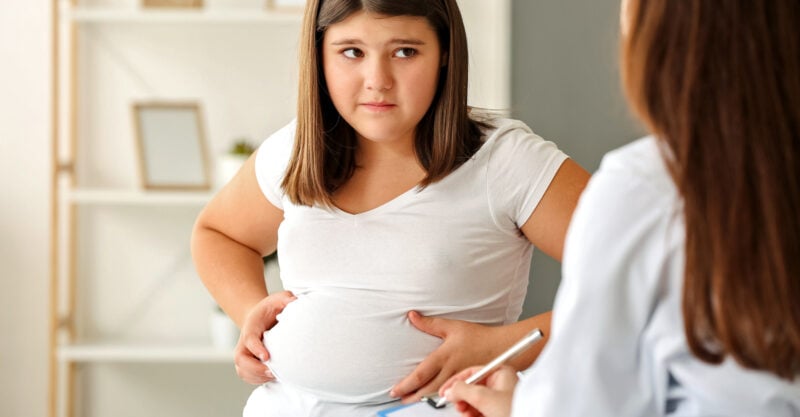Miss a day, miss a lot. Subscribe to The Defender's Top News of the Day. It's free.
As obesity rates among U.S. kids and teens continue to soar, more children and adolescents in the U.S. are undergoing weight-loss surgery, a new peer-reviewed study concluded.
According to the JAMA Pediatrics study, severe obesity is the “fastest-growing obesity subcategory in the US pediatric population.”
The researchers — including Sarah Messiah, Ph.D., MPH, professor of epidemiology at UTHealth School of Public Health in Houston, Texas — said the rate of invasive medical procedures on the gastrointestinal tract among 10- to 19-year-olds has been on the rise since 2016 and jumped by nearly 20% between 2020 and 2021.
“This analysis shows that families are making the decision to pursue bariatric surgery more frequently year-over-year,” Messiah said in a news release. The increase was most pronounced “among those from racially and ethnically diverse backgrounds,” she said.
Commenting on the new study, pediatrician Dr. Lawrence Palevsky said, “Our medical community is failing our children by deciding that the best way to treat them [for obesity] is through medication and surgery.”
These measures do nothing to address the underlying factors that are negatively impacting the children’s health, such as “their psychology, their home environment, their diet, and the overall sociological issues with which they’re dealing,” Palevsky told The Defender.
Palevsky said many medical professionals refuse to acknowledge the role that diet and the environment both play in the health and welfare of children.
Palevsky’s first medical school instructor “within the first five minutes of introducing himself to the class, made it a point to let us know that nutrition is not a field of medicine,” he said.
The prevailing mentality is that “We, in the medical world, solve your problem by cutting you up and fixing you” — and then patients can go back to their lives and make the dietary and environmental choices they were just making all along.
“So go ahead, drink your beverages with high-fructose corn syrup … and play as many video games and computer games as you want so that you’re not physically active and we will just take you to the operating room and solve your problem.”
Palevksy said although he was “conventionally trained,” his approach to medicine is “to get to the root cause and to the contributing factors that are bringing on symptoms” — rather than using pharmaceuticals to suppress or treat symptoms — and “to educate parents and their children so they can resolve illness more easily.”
An increase in weight-loss surgeries among youth likely could lead to more medical errors — which researchers say is a leading cause of death in the U.S.
In a 2016 analysis published in the BMJ, John Hopkins University School of Medicine researchers said that more than 250,000 deaths per year were due to medical error — making medical error the third leading cause of death in the U.S.
‘Too quick to reach for a pill or surgical solution’
Earlier this year, the American Academy of Pediatrics (AAP) issued new clinical guidelines for treating childhood obesity that endorsed weight-loss pharmaceuticals and — for the first time ever — more weight-loss surgeries as “safe and effective” treatments for childhood obesity.
The two AAP-approved methods of weight-loss surgery for children — sleeve gastrectomy or gastric bypass — entail removing or rendering permanently dysfunctional a large percentage of the stomach.
“Our analysis suggests that these access channels are being utilized, and more frequently, even during the COVID-19 pandemic,” Messiah said.
Meanwhile, critics — including Dr. Paul Thomas, an integrative pediatrician — said the increased “market” for weight-loss surgeries performed on children fails to address the root cause of children’s obesity.
“We are too quick to reach for a pill or a surgical solution,” Thomas said. “Addressing the root cause and underlying conditions that have resulted in obesity will give lasting results that will also promote physical, emotional and spiritual healing.”
Thomas, the subject of a book on how he lost his medical license after publishing a controversial study on the health of his vaccinated patients versus those unvaccinated, told The Defender:
“While there may be rare special circumstances where bariatric surgery for morbid obesity in children may make medical sense, the major focus should be lifestyle changes after endocrine etiologies have been ruled out.
“The AAP endorsement of this surgery may create a market for surgeries in children that could easily be avoided by proper attention to the underlying cause of the obesity, which in many cases is related to stress, poor nutritional choices, lack of exercise, inadequate sleep and psychological and emotional duress.”
1 in 5 American kids are obese
The Centers for Disease Control and Prevention (CDC) defines obesity as “a body mass index (BMI) at or above the 95th percentile of the CDC sex-specific BMI-for-age growth charts.”
According to the CDC, the most recent national statistics show that 14.7 million children and adolescents ages 2-19 are obese. That equates to a child obesity rate of 19.7% — meaning roughly 1 in 5 kids is obese.
Obese children are at greater risk of developing related functional, metabolic and psychological conditions, experiencing pervasive weight bias and stigma and having greater healthcare costs.
Childhood obesity also is strongly correlated with the risk of adult obesity and poor health, with considerable social and economic consequences.
The proportion of U.S. children who are overweight or obese surged to unprecedented levels during the COVID-19 pandemic, according to CDC data.
Public health experts cited economic hardship, school closings, shutdowns, limited physical activities and increased food insecurity for many families caused by COVID-19 mitigation measures as reasons for the surge.
Palevsky noted that many children living in inner cities do not have access to fresh food.
Dr. Hooman Noorchashm, a general and cardiothoracic surgeon with more than 20 years of experience, commented on the same problem.
In the area of Philidelphia where Noorchashm lives, he said, “You can go to McDonald’s and buy a thousand calories worth of food for 4 or 5 bucks at McDonald’s [but] you can’t get a healthy salad for less than 20 bucks.”
Surgeon: ‘I personally would never subject my child … to bariatric surgery’
Childhood obesity is a “real clinical problem,” Noorchashm said — but it’s a “multifactorial problem” that has a great deal to do with “access to healthy food and people’s relationship to food.”
And when comes to addressing the problem, an ounce of prevention is worth a pound of treatment, he added.
Noorchashm said there was “no question” that severely obese children “need effective treatments.”
However, when treatments — like weight-loss surgeries and weight-loss medications — are “so lucrative,” it creates an economic incentive to focus research and government funds on treatments rather than on prevention, he said.
Within the AAP, there is a society of pediatric surgeons and pediatric bariatric surgeons, Noorchashm said. “These organizations have lobbying power.”
“It’s a problem of economy,” he said, adding:
“In other words, because the Bandaid costs so much and so many special groups are making money off it, regulatory incentive decreases to actually solve the root cause …
“I personally would never subject my child or any child that’s related to me to bariatric surgery.”
According to Palevsky, government and food industry leaders — including the U.S. Department of Agriculture (USDA) — should be held responsible for providing kids with nutritious foods.
Instead, as The Defender recently reported, more highly processed foods will be on the menu for children in public schools this fall thanks to a “major new initiative” to get Kraft Heinz’s “Lunchables” products into U.S. public school cafeterias.
Two styles of Lunchables ostensibly meet the federal nutritional guidelines set for the USDA National School Lunch Program, which provides meals to nearly 30 million kids across the country.
Commenting on the AAP’s new guidelines for treating childhood obesity, Mary Lou Singleton, midwife and family nurse practitioner, said they “offered no meaningful analysis or explanation of what is driving the childhood obesity epidemic.”
Singleton added:
“I found no mention of the massive changes in the U.S. food supply that correlate with the skyrocketing rates of obesity among children and adults alike …
“The document fails to address the school lunch program, which is providing a significant amount of the calories U.S. schoolchildren are eating weekly. Most schoolchildren in the U.S. are fed plastic-wrapped, chemically-preserved, pesticide-laden food made in factories months or years earlier.
“In addition to the sugar, the chemicals in these foods have endocrine-disrupting obesogenic properties.”





